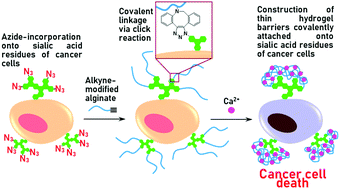A thin hydrogel barrier linked onto cell surface sialic acids through covalent bonds induces cancer cell death in vivo†
Abstract
Hypersialylation is the aberrant expression of sialic acid in cell surface glycans and is pervasive in cancer cells. Recent studies have shown that hypersialylation provides a microenvironment conducive to cancer progression, mediated by the interaction between sialic acid and sialic acid-binding receptors. Therefore, a technique to block the interaction between the overexpressed sialic acid on cancer cell surfaces and its receptors is a promising approach to develop new cancer therapies. We focused on hydrogels as an artificial barrier to block this interaction and present here the development of a novel technique for selectively covalently binding a thin hydrogel barrier on sialic acid residues on cancer cell surfaces. This technique effectively inhibited cancer cell adhesion, motility and growth, caused cancer cell death in vitro, and completely suppressed tumor growth in vivo, thereby clearly demonstrating a potent antitumor effect.



 Please wait while we load your content...
Please wait while we load your content...